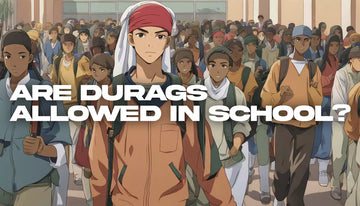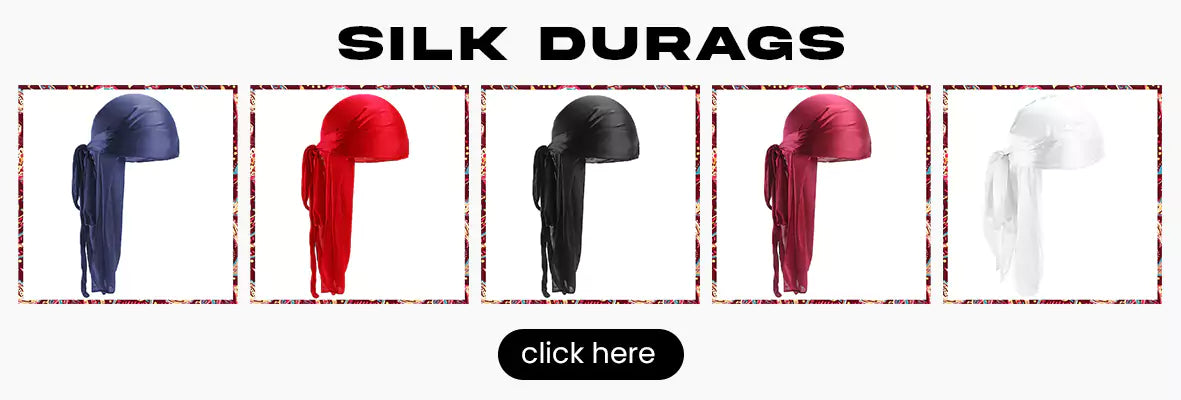If you're a student or a parent of a student in the United States, you may be wondering whether durags are allowed in school. Durags are head coverings worn by the black community to protect their hairstyles and promote hair growth.
Some schools allow them, while others prohibit them due to concerns over gang affiliation or violations of strict clothing policies. This has led to debates over whether such bans infringe on students' right to express themselves.
Key Takeaways:
- Durags are an important expression of black culture and identity.
- Some schools allow durags, while others have banned them due to concerns over gang affiliation or dress code violations.
- Whether durags should be allowed in schools centers around cultural sensitivity and freedom of expression.
Durags and Their Significance in Black Culture
Durags have been worn by African Americans for generations, tracing their origins back to slaves in the 19th century. The simple piece of cloth has evolved over time and was particularly prominent during pivotal eras like the Harlem Renaissance and Great Depression. Nowadays, durags are commonly associated with African American culture and are a staple in the black community. They've done a great job transitioning into mainstream awareness, becoming a style of clothing linked with Hip Hop culture. Interested in learning more? You'll love our article on the history of durag!
School Dress Codes and Their Impact on the Right to Wear Durags
As a black student, you may know the term "dress code." It's a set of rules that dictate what you can and can't wear to school. Dress codes can be strict, prohibiting certain clothing items or accessories. Unfortunately, durags are often banned in school dress codes, even though they are essential to black culture.
One of the reasons durags would not be allowed is that they are considered a head covering. Most schools prohibit head coverings, including the option to wear a hat, for security reasons such as preventing students from hiding their faces or concealing weapons. However, a durag is not a security threat. It's a cultural accessory used to maintain a hairstyle, protect hair from damage, or even keep hair in place during sleep. Therefore, banning durags based on being a head covering is an unfair and uninformed decision.
Furthermore, dress code restrictions can impact black students' freedom of expression and cultural identity. Durags are a part of black culture and have been worn by Africans for generations to maintain specific hairstyles. Banning durags means black students cannot express a crucial aspect of their identity, a significant loss of cultural affirmation and belonging.
Strictly enforcing dress codes without considering the cultural significance of certain fashion items can also create a hostile environment for black students. When black students cannot express themselves through their clothing choices, it can lead to feelings of isolation, marginalization, and stigmatization. The use of dress codes should never diminish cultural identity.

Schools have sometimes implemented bans on durags, citing concerns about gang affiliation. However, this notion is a misconception rooted in negative stereotypes. Durags are not inherently connected to gang culture; they are cultural headwear worn by men and women. Banning durags can also reinforce harmful stereotypes that negatively impact black students.
The freedom of expression is a fundamental right for all students, regardless of their cultural identity. School dress codes should accommodate diverse cultural practices and respect students' artistic expressions. Banning durag may be discriminatory and can harm students by denying them the right to express themselves freely.
Ultimately, the debate surrounding du-rags and dress codes in schools highlights the need for greater understanding and inclusivity. Schools should strive to create an environment where cultural practices are respected and celebrated, not marginalized and excluded. By doing so, they can help foster a sense of belonging and empowerment for all students.
Durags Should Be Allowed in Schools?
The question of whether durags should be allowed in schools is a contentious one, with arguments on both sides of the debate. Some argue that durags should be prohibited due to their association with gang culture and the potential for disruption in the classroom. Others say that such restrictions are discriminatory and infringe upon students' rights to express their cultural identity.
Those who favor allowing durags in schools argue that they are an essential part of black culture and serve as a form of expressivity for young black men. Advocates assert that students are allowed to wear a durag at school to maintain specific hairstyles, such as cornrows, and as a symbol of affiliation with the black community. Banning durags from the classroom can thus be seen as a form of institutionalized racism and an attempt to dictate what is considered acceptable in terms of dress and appearance.
On the other hand, those who support a durag ban in schools argue that the accessory is often associated with gang culture and can be a distraction in the classroom. Some concerns are that allowing durags may promote gang affiliation and lead to safety issues on school grounds. Additionally, some dress codes prohibit head coverings, including durags, for hygiene and security reasons.
However, it is important to note that the association between durags and gang culture is largely a myth, and the majority of people who wear durags do so for cultural reasons and not for any gang affiliation. Banning durags based on this misconception perpetuates negative stereotypes and can further marginalize pupils.
In conclusion, the debate surrounding the allowance of durags in schools is complex and multifaceted. While dress code policies should be in place to ensure a safe and appropriate learning environment, it is also important to consider students' rights to express themselves and their cultural identities. Promoting inclusivity, understanding, and education around such cultural practices can help create a more accepting and welcoming environment for all students.

Why Banning Durags in Schools Affects Black Students
Banning durags in schools disproportionately affects black students mainly because this headwrap is deeply rooted in their cultural identity. Durags can be used to protect the hair, lock in moisture, and prevent frizz. By prohibiting the use of durags, schools are essentially limiting the expression of black students and infringing upon their cultural practices.
Some think that durags should not be allowed on school property, linking them to a style of clothing that's not considered neat and tidy. This perspective commonly clashes with the view that anyone can wear a durag and it's a part of a broader culture that should be respected. The U.S. has seen debates around wearing hats and hood garments indoors, and durags have found themselves roped into these discussions.
Not only does this ban undermine the importance of cultural diversity, but it also perpetuates stereotypes and discrimination. It is unfair to expect black students to conform to Eurocentric standards of grooming, especially when specific care is needed to keep their hair in its natural texture. Additionally, this ban directly impacts black students’ self-esteem and confidence, as they may feel compelled to conform to the dominant culture's standards to fit in. Instead of banning durags, schools should encourage acceptance and understanding of diverse cultures, promoting an inclusive environment where all students feel respected and valued for who they are.
Can You Wear a Durag to Work?
Whether or not durags to work largely depends on the workplace dress code policies. In most professional settings, such as schools, teachers and administrators must adhere to a more formal dress code. This usually involves wearing attire that is considered appropriate and conservative. A durag, often worn to maintain and protect certain hairstyles, may not conform to these ideals, as it is seen as a casual accessory more commonly associated with informal settings or leisure activities.
However, as workplaces become more diverse and inclusive, some institutions may have more relaxed dress code policies or be more accepting of cultural or religious practices that involve using a durag. In such cases, employees could wear a durag to work, provided it is tastefully worn and in line with the overall dress code guidelines. Ultimately, consulting with one's employer or human resources department is important to clarify any doubts or concerns regarding specific dress code regulations.

Separating Durags and Gang Affiliation Myths from Facts
Durags have often been associated with gang culture, leading to negative stereotypes and misrepresentations. However, the truth is far more complex.
Durags became popular in the 1970s and 1980s for black men to style their hair and maintain wave patterns. They were never intended to be associated with gangs. Durags were worn by people of all ages and affiliations as a cultural item and a symbol of the black power movement.
| Myth | Fact |
|---|---|
| Durags are only worn by gang members. | Durags are worn by men and women of all ages and communities. |
| Wearing a durag is a sign of gang affiliation. | Wearing a durag is a form of individualism and cultural representation. |
| Durags are symbol of gang culture. | Durags are a symbol of black identity and style. |
It is important to recognize that durags are not inherently linked to gang culture and that the association is based on harmful stereotypes. By dispelling these myths and misconceptions, we can better understand the cultural significance of durags and promote inclusivity and understanding within our schools and communities.
Legal Aspects of Student Dress Codes and Rights
You may be wondering about the legal implications of wearing a durag to school. While schools have the right to establish dress codes, these codes must comply with federal and state laws, including students' constitutional rights to freedom of expression.
If a dress code policy prohibits explicitly durags, you may not be allowed to wear them at school. However, if the policy does not specify durags or head coverings in general, then you may have a reasonable argument for wearing them in public.
It is important to note that durags are also been erroneously associated with gang affiliation, which may be why schools restrict their use. However, this association is not supported by facts and has contributed to negative stereotypes about black culture.
If you believe that a durag ban violates your rights to express your cultural identity, you may want to seek legal counsel and consider your options. Ultimately, the goal should be to promote understanding and inclusivity within schools while respecting the need for order and safety.

Overall, the legal considerations surrounding durags and dress codes in schools require careful examination of individual rights and institutional responsibilities. By promoting dialogue and education about cultural practices and the historical context of durags, we can work towards creating a more inclusive and accepting climate for all students.
Ultimately, allowing students to wear durags to school signals respect for their cultural identity and promotes inclusivity within the school community. By recognizing the importance of durags within black culture, we take a meaningful step towards creating an environment that respects and values all students, regardless of their cultural background.
Conclusion
In conclusion, whether durags should be allowed in schools is complex and multifaceted. On one hand, durags have significant cultural and personal significance for many pupils, serving as a form of self-expression and identity. On the other hand, strict dress codes and concerns around gang affiliation have led to durags being banned or restricted in some schools.
It is important to recognize the role of dress codes in maintaining a professional and safe learning environment, but it is equally important to understand the impact of such policies on students' freedom of expression and cultural identity. Banning specific garments can send negative messages and perpetuate harmful stereotypes.
Ultimately, it is up to each school community to determine their policies around dress codes and cultural expression. But by prioritizing inclusion and understanding, we can create a more positive and equitable learning environment for all students.
FAQ
Q: Are durags allowed in school?
A: The allowance of durag at school depends on each institution's specific dress code policies. Some schools may prohibit wearing durags, while others may have no explicit restrictions. It is important to refer to your school's dress code guidelines to determine whether durags are allowed.
Q: What is the cultural significance of durags?
A: Durags have a long history within black culture and serve as more than just a fashion accessory. They are a form of self-expression and a way for individuals to showcase their affiliation with the black community. Durags are deeply intertwined with black identity and representation.
Q: Do dress codes impact the use of durags in school?
A: Yes, dress codes can impact the use of durags in school. Some schools may have strict dress code policies that prohibit head coverings, which could include durags. Such restrictions can limit students' freedom of expression and affect their cultural identity.
Q: Should durags be allowed in schools?
A: The debate surrounding the allowance of durags in schools is multifaceted. Some believe that durags should be allowed as they are important to black culture and self-expression. Others express concerns about potential gang affiliation or distraction in the school environment. Different perspectives exist, and it is a topic that requires careful consideration.
Q: What are the legal considerations regarding durags and dress codes?
A: The legal considerations surrounding durags and dress codes vary. Students have the right to express their cultural identity through fashion choices, and outright banning specific garments, such as durags, may raise constitutional concerns. It is essential to examine the legal precedents and understand students' rights in relation to dress codes.
Q: How can schools promote cultural inclusivity regarding durags?
A: Schools can promote cultural inclusivity by recognizing and respecting different cultural practices, including wearing durags. Open dialogues, workshops, and curriculum integration can educate students and staff about various cultural expressions and foster a more inclusive and accepting environment.
Q: Why is it important to understand and appreciate durags?
A: Understanding and appreciating durags is crucial for creating an inclusive school community. Allowing durags and embracing diverse cultural practices, like wearing durags, promotes cultural sensitivity and supports black students' well-being and sense of belonging.
Q: How can dialogue and education be promoted regarding durags?
A: Promoting dialogue and education about durags can be achieved through open conversations, workshops, and curriculum integration. These efforts help raise awareness, challenge stereotypes, and enhance understanding among students and staff members.
Q: What is the conclusion regarding durags in schools?
A: In conclusion, whether durags should be allowed in schools is complex and requires careful consideration of cultural inclusivity, freedom of expression, and understanding. Recognizing the cultural significance of durags and promoting an inclusive environment can positively impact students' well-being and sense of identity.









